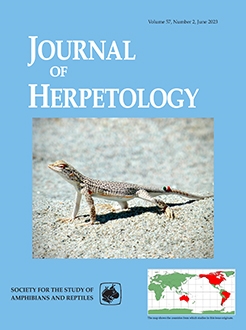The Wood Turtle (Glyptemys insculpta) is a semiaquatic turtle species that has been known to exhibit intersexual variation in habitat use during summer. Males often remain near watercourses in riparian areas, whereas females tend to move upland and spend more time in terrestrial environments postnesting. Dietary niche partitioning is one of several hypotheses proposed to explain why females leave aquatic habitats in search of terrestrial food resources. The presence of dietary niche partitioning within a population of Wood Turtles in central New Brunswick, Canada, was assessed using stable isotope analysis. Male and female Wood Turtles were sampled in spring and summer 2021. Potential invertebrate foods were sampled and grouped into pond, stream, and terrestrial food sources. Using stable carbon (δ13C) and nitrogen (δ15N) isotopic ratios of extracted red blood corpuscle and blood plasma, the resource use and isotopic niche widths of individuals within the population were compared between seasons and sexes. Results indicated no significant differences in δ13C and δ15N values, dietary contributions, or isotopic niche widths between spring and summer samples or between males and females. We determined that terrestrial invertebrates were an important food source (>72% mean diet contribution) across the entire sampled population, with invasive Arion slug species constituting a large portion of turtle diets. Our findings indicate that dietary niche partitioning is most likely not the explanation for sexual variation in habitat use by Wood Turtles.
BioOne.org will be down briefly for maintenance on 17 December 2024 between 18:00-22:00 Pacific Time US. We apologize for any inconvenience.
How to translate text using browser tools
21 December 2023
A Test of Intersexual Trophic Niche Partitioning within a Population of Wood Turtles (Glyptemys insculpta)
Jesse Bellamy,
Damien Mullin,
Bobby Nakamoto,
Brian Hayden,
Christopher Edge
ACCESS THE FULL ARTICLE

Journal of Herpetology
Vol. 57 • No. 4
December 2023
Vol. 57 • No. 4
December 2023




